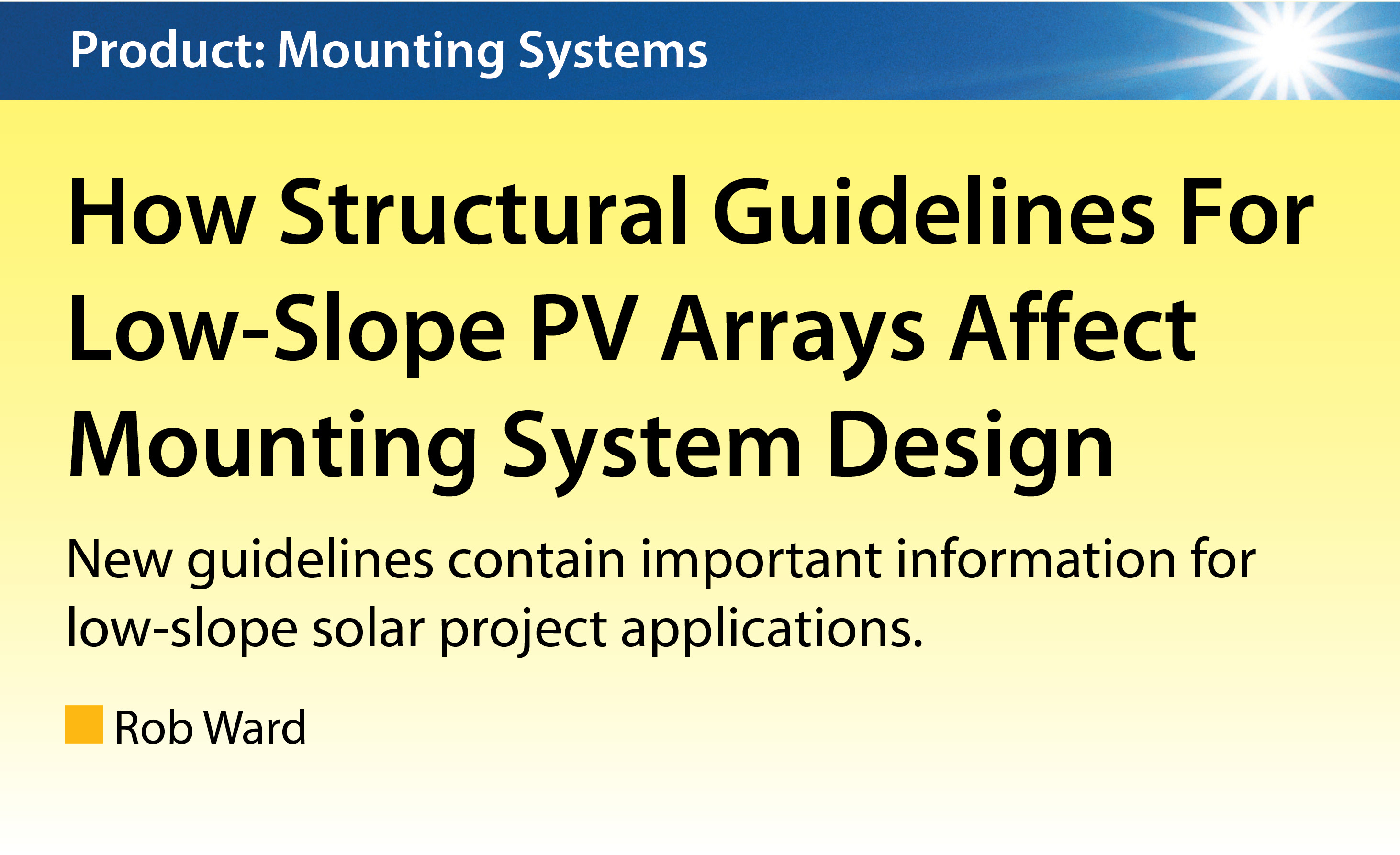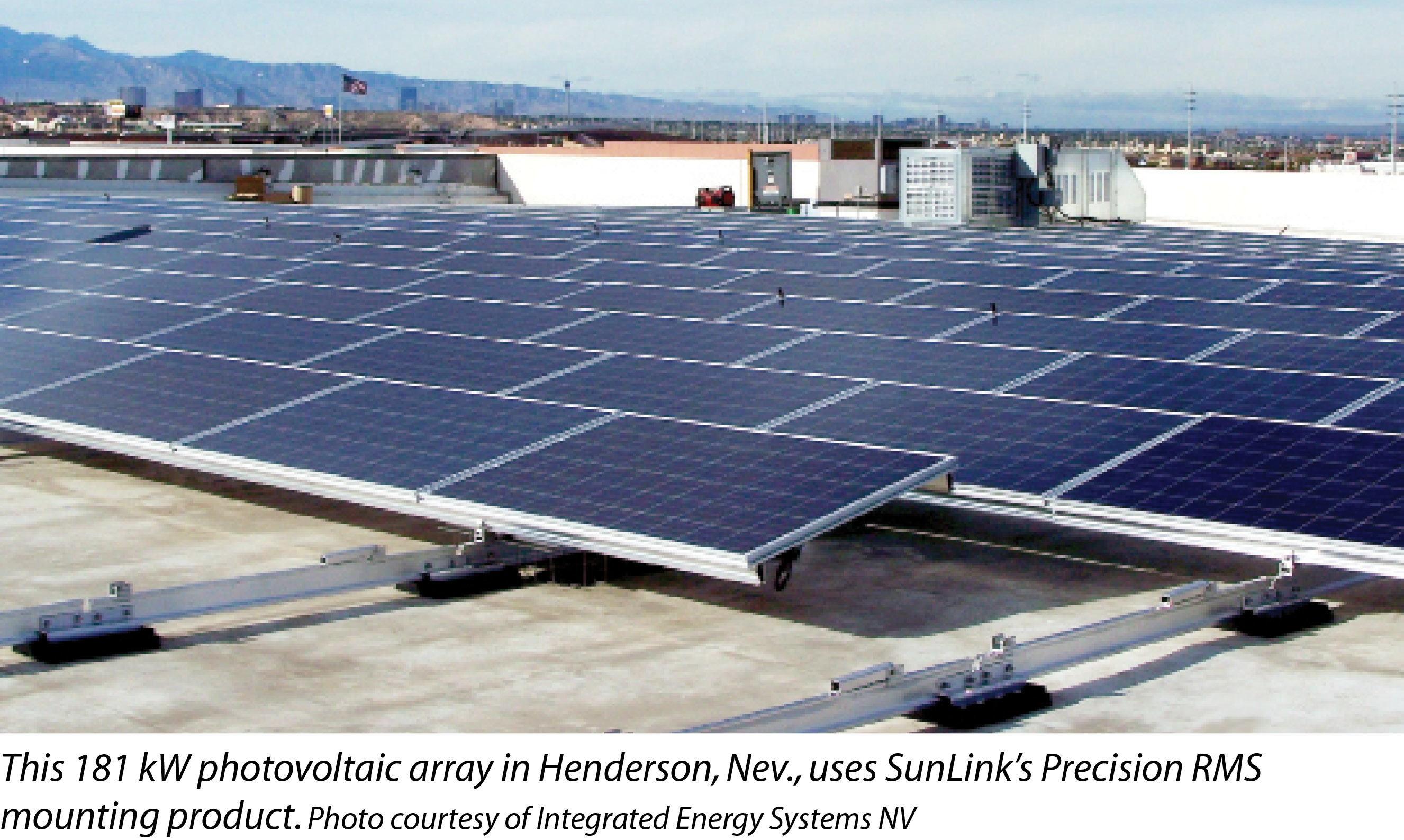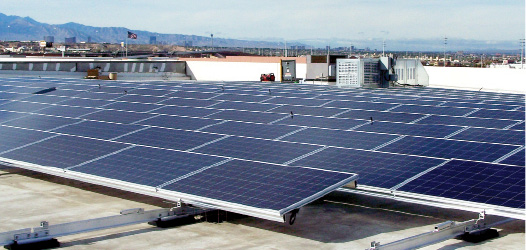

301 Moved Permanently
Tilted, low-profile photovoltaic solar arrays on low-slope roofs have become - and will continue to be - the preferred way to deploy photovoltaics because these arrays provide electricity close to where it is needed, making use of otherwise unused rooftop real estate.
However, despite the popularity of this approach, structural engineers have struggled to find appropriate design guidance for low-slope roof mounting structures.
These types of solar arrays have unique characteristics related to their extent, geometry, weight and method of connection to the building that are not addressed in the current U.S. building codes. So, when structural engineers turn to the U.S. building code standard SEI/ASCE 7-10, “Design Loads for Building and Other Structures,” to determine design requirements - as is done for other rooftop equipment - they do not find any comprehensive guidance addressing the unique characteristics of these structures, particularly when it comes to wind and seismic effects.
As consulting engineers and racking manufacturers have continued to work to understand the design requirements for these systems, new insights, new design ideas and new racking products have emerged. But the lack of authoritative published guidelines has continued to make it difficult for building officials and other stakeholders to evaluate whether any low-slope roof product or project design is structurally adequate.
This uncertainty concerning the structural design of low-slope roof mounted systems has been detrimental to this segment of the solar market.
To answer the need for PV-specific guidelines, in 2011, the Structural Engineers Association of California (SEAOC) formed the Photovoltaic Systems Committee (SEAOC PV Committee) to develop and publish structural guidance for PV arrays that can improve the structural design consistency and structural reliability of PV racking products.
The SEAOC PV Committee consists of consulting structural engineers, building officials, industry members, wind tunnel research experts, and members of other national code committees and the SEAOC seismology committee.
The SEAOC PV Committee issued its first two guideline documents in August 2012. These guidelines are titled “Structural Seismic Requirements and Commentary for Rooftop Solar Photovoltaic Arrays” (PV1-2012), which discusses the design of low-slope rooftop systems in earthquake-prone areas, and “Wind Design for Low-Profile Solar Photovoltaic Arrays on Flat Roofs” (PV2-2012), which addresses design wind loads on these types of systems.
Both documents present new information that will benefit structural engineers and others tasked with designing or checking tilted PV arrays on low-slope roofs.

Code requirements
Although current building codes do not contain specific guidance for low-slope PV arrays, the codes do allow building officials to approve “alternate materials and methods” - designs that do not follow prescriptive building code requirements but nonetheless are shown to meet the code’s intent.
Until building codes contain specific requirements for PV arrays on low-slope roofs, information in the SEAOC publications PV1-2012 and PV2-2012 can be used to help ensure that the alternate materials and methods used for low-slope rooftop PV arrays meet code intent in terms of safety and performance and therefore can be deemed code-compliant.
The PV1-2012 and PV2-2012 guidelines provide information that will help bring consistency to the design of low-slope rooftop racking systems, and they also will help to inform the next generation of U.S. building code documents.
PV1-2012 covers a number of important topics related to the design of low-slope rooftop PV arrays in high seismic areas. It provides guidance for calculating design forces for roof attachments, particularly for systems where the PV system’s weight bears on the roofing and is not supported by the attachments. Often, roof-bearing systems may use some attachments to the roof structure to help resist wind loads.
Although SEI/ASCE 7 prescriptively precludes the use of friction from gravity loads (system weight) when calculating attachment capacity requirements, PV2-2012 presents a method to account for some friction when the seismic forces on these attachment points are calculated. This is an appropriate approach for roof-bearing systems that have many friction contact points with the roof over a relatively large area.
Because PV arrays are often added to existing buildings, PV1-2012 focuses primarily on the design of roof-bearing systems without attachments to the roof structure - i.e., ballast-only systems. Ballast-only systems avoid the cost and increased water intrusion risk caused by the roofing penetrations needed for attached systems.
However, these systems are not allowed by the prescriptive seismic requirements in SEI/ASCE 7 because, as mentioned above, the guideline requires connector forces to be determined without considering friction caused by gravity loads. The design method in PV1-2012 for ballast-only systems is a displacement-based method and can be considered an alternate method of code compliance when approved by the building authority having jurisdiction.
Recent analytical work and shake table tests have shown that well-constructed ballast-only PV arrays on low-slope roofs behave in a predictable manner under strong earthquake shaking. For these systems, the displacement of the array during a strong earthquake can be characterized based on site seismicity, the coefficient of friction between the array-bearing pads and the roofing bearing surface, and roof slope.
PV1-2012 presents a prescriptive method for the seismic design of ballast-only PV arrays, based on determination of a design seismic displacement. The document also discusses possible related design issues, such as freezing conditions, roof load-carrying capacity and wiring slack.
Because the amount of friction between a roof-bearing array and the roofing is key to its seismic behavior, PV1-2012 also provides requirements and recommendations for friction testing. PV1-2012 requires, in fact, that the coefficient of friction be determined by testing in high seismic zones.
Furthermore, it lists the necessary components of a successful friction testing plan, including the use of full-scale test sleds, details on pulling the sleds, and reporting requirements.
The document also provides information for engineers and racking manufacturers interested in performing computer structural analysis and shake table testing similar to the work that forms the basis for PV1-2012 prescriptive method.
Two different possible analytical approaches are described, along with key requirements for shake table tests. Engineers and racking manufacturers might wish to use these methods to arrive at more accurate, less conservative displacements than the prescriptive method provides, or less restrictive requirements than the prescriptive method allows.
Wind testing
SEAOC PV2-2012 describes the low-slope rooftop environment during a windstorm, proposes new SEI/ASCE 7-10 language for the determination of design wind loads and presents requirements for boundary layer wind tunnel testing.
Wind flow over a typical rectangular low-rise building is well understood, and structural engineers are very familiar with using SEI/ASCE 7 to determine the resulting design wind pressures. However, recent research has shown that wind loads on PV arrays differ significantly from the loads described in SEI/ASCE 7 for building cladding and rooftop equipment.
Wind pressures on low-slope rooftop PV modules are generated by the wind’s interaction with both the array’s geometry and the building’s geometry. Separation vortices are formed when wind passes over sharp edges. The tops of building walls and building corners can produce strong vortices that then interact with the array’s panel edges.
A turbulent wind environment can lead to panel lift, downward forces and drag forces that the racking must be designed to safely resist. Anyone interested in wind loads on rooftop PV arrays will find this part of PV2-2012 an interesting read.
PV2-2012 also presents a prescriptive method for determining design wind loads on low-slope rooftop arrays that is in accordance with SEI/ASCE 7. This method is presented as additional language to SEI/ASCE 7-10, including commentary and a design figure similar to those used in SEI/ASCE 7.
The method yields load values for common array geometries used for low-profile (close to the roof) systems, with the exception of those that use shrouds to partially enclose the openings between the edges of the panel and roof. Because testing has shown that design wind loads on shrouded systems are sensitive to the shroud geometry, it was not possible to provide generic guidance for shrouded systems in the prescriptive method.
However, the method and issues addressed are the same for these systems, and the outlined procedure can be used with product specific aerodynamic coefficients substituted for those of the generic systems provided in the method.
The key design factors addressed by PV2-2012 include PV panel geometry and size, building plan shape and size, parapets, location of the roof and location of the array. The design values and methodology presented in the guide are based on boundary layer wind tunnel testing done at two leading North American wind tunnel laboratories. Both of these laboratories have done extensive testing of wind effects on low-rise buildings and, in particular, PV arrays on the rooftops of such buildings.
PV2-2012 also contains guidance on the effective wind area to use when determining wind loads on different PV array components, as well as design examples using the prescriptive method.
Future code development
Racking manufacturers often use boundary layer wind tunnel (BLWT) testing to determine design wind loads for their racking products. As mentioned previously, this is often important for shrouded systems, and it is useful for any system when design wind loads for a specific array geometry are desired.
SEI/ASCE 7 provides basic requirements for boundary layer wind tunnel modeling and testing, labeled Method 3 in SEI/ASCE 7-05 and the Wind Tunnel Method in SEI/ASCE 7-10. However, because the SEI/ASCE 7 standard is concerned with modeling and testing a specific site and building, it does not address the use of wind tunnel testing to develop design wind loads for a rooftop system that will go on numerous, different buildings.
The PV2-2012 document provides the needed missing information and specifies requirements for the use of BLWT testing to determine generalized design wind loads. PV2-2012 also provides requirements for reporting and third-party expert reviews of BLWT testing, and it identifies when such reviews are required.
Future versions of U.S. building code standard SEI/ASCE 7 and the International Building Code model code will likely contain more detailed structural design guidelines specific to low-slope rooftop PV systems. Both of the SEAOC PV Committee’s new documents present ideas that will be part of discussions as new versions of these code documents are developed.
Members from the SEAOC PV Committee are currently working to bring both documents before the national committees that have begun work on SEI/ASCE 7-16. They are also providing input during the annual International Code Council revision cycles that are developing the 2015 International Building Code.
Meanwhile, the information contained in these new SEAOC documents can currently be used as a basis for building code performance-level design of these arrays for wind and earthquakes. These new documents provide engineers with the information they need to design low-slope rooftop arrays and mounting systems more economically, while helping to ensure that code-required levels of structural safety and structural performance are provided
In California, the 2013 California Building Code allows for the acceptance of unattached PV arrays on low-slope roofs in certain cases. The California Division of the State Architect - the statewide authority having jurisdiction for public schools and junior colleges - has already incorporated both the PV1-2012 and PV2-2012 documents into its requirements for low-slope rooftop systems.
Time will tell if other states follow suit in advance of new national building code guidelines. R
Product: Mounting Systems
How Structural Guidelines For Low-Slope PV Arrays Affect Mounting System Design
By Rob Ward
New guidelines contain important information for low-slope solar project applications.

si body si body i si body bi si body b
si depbio
- si bullets
si sh
si subhead
pullquote
si first graph
si sh no rule
si last graph